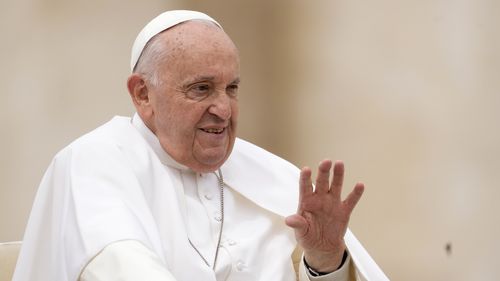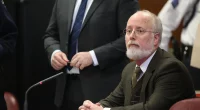Share this @internewscast.com
The first clue of the next pope’s direction will be the name the winner chooses.
The phrase “Habemus Papam” â or “We have a pope” â announced from the balcony of St. Peter’s Basilica is succeeded by the declaration of the new pope’s baptismal name in Latin, followed by his chosen papal name, rich with significance.
A Pope Francis II would signify continuity with the late pontiff’s pastoral legacy and his prioritising of the marginalised.

Francis himself quipped that his successor would be John XXIV, after the progressive Vatican II-era pope.
The most popular papal name of the 20th century, Pius, would be a clear signal that a traditionalist is taking back the throne of St Peter.
“In the deepest corners of their minds, when they begin the conclave, each will enter with a name they are considering,” stated Natalia Imperatori-Lee, the chair of the religious studies department at Manhattan University.
For most of the Catholic Church’s first millennium, popes used their given names.
The first exception was the 6th century Roman Mercurius, who had been named for a pagan god and chose the more appropriate name of John II.
The tradition of adopting a new name became established during the 11th century, a time of German popes who selected the names of early church bishops as a way to express “a desire to signify continuity,” explained Reverend Roberto Regoli, a historian at Rome’s Pontifical Gregorian University.
For many centuries, new popes tended to choose the name of the pope who had elevated them to cardinal.
John was the most popular, chosen by 23 popes, followed by Benedict and Gregory, each with 16.

Funeral of Pope Francis: World leaders and royals pay their respects
Only starting in the mid-20th century did new popes begin to choose names signalling the aim of their papacy, Regoli said.
âEven now, as we are waiting for the new pope, the name with which he will present himself will help us to understand the horizon towards which he wants to proceed,” Regoli said.
Some names have been out of use for centuries, like Urban or Innocent.
âI donât think anyone will pick Innocent,â³ Imperatori-Lee said, given the abuse and other scandals that have rocked the church.
âI donât think that would be the right choice.”
FRANCIS: Pope Francis, elected in 2013, took the name of St Francis of Assisi, known for his humility, life of poverty and love of all creatures.
With it, Francis signalled a papacy focused on those who are often seen as outsiders, including the poor, prisoners and the LGBTQ+ community, while promoting peace, brotherhood and care of the environment.
BENEDICT: Last chosen by German Cardinal Joseph Ratzinger, elected in 2005.
Pope Benedict XVI said he wanted to pay homage to Benedict XV, who led the church during World War I and dedicated himself to healing the rifts of war, and to the 6th century St Benedict, founder of Western monasticism, who helped spread Christianity throughout Europe.
One of Benedict XVIâs priorities was trying to revive the faith in Europe.
âIf we get a Benedict, then we will know that the cardinals chose to see Francis as an anomaly,” Imperatori-Lee said.

JOHN PAUL: The papacy’s first composite name was chosen by Cardinal Albino Luciani in 1978 to honour Pope John XXIII, who opened the Vatican Council II process that reformed the Catholic Church, and Paul VI, who closed it.
The name signalled a commitment to reforms, including sidelining the Latin Mass in favour of local languages and opening to other faiths, most significantly Judaism.
John Paul Iâs papacy lasted just 33 days.
Polish Cardinal Karol Wojtyla, who succeeded him, chose the name John Paul II.
JOHN: Chosen 23 times by popes, most recently in 1958 by Pope John XXIII.
John can refer to St John the Apostle, one of Jesus’ 12 apostles and the author of one of the Gospels, or St John the Baptist, the prophet who baptised Jesus.
âJohn the XXIII was a pope that no one expected a lot from, but had a colossal impact on the church,” Imperatori-Lee said.
âSo that could be a sign of what they want their pontificate to be like.”
PAUL: Chosen six times, most recently in 1963 by Paul VI.
St Paul the Apostle spread the teachings of Jesus in the 1st century.
PIUS: It is associated with popes known for their traditionalist, anti-reform bent.
Pius IX ordered the kidnapping of the Jewish boy Edgardo Mortara in 1858 and raised him Catholic in the Vatican after learning he had been secretly baptised by a housekeeper; Pius X was the early 20th century anti-modernist who inspired the anti-Vatican II schismatic group, the Society of St. Pius X; Pius XII was the World War II-era pope criticsed for not speaking out sufficiently about the Holocaust.
“It is now a name that is hostage to some Catholic groups that can be considered traditionalists,” Regoli said.

Pope Francis’s tomb seen for first time in images released by Vatican
A new pope is free to choose a name never used before, as Francis did.
âThis would open a new season and could mean that his program is not in line with any of his predecessors, so an even more personalised program,” Regoli said.
Imperatori-Lee suggested another name that might signal a continuation of Francis’ legacy: Ignatius, for the founder of Francis’ Jesuit order.
âIt would be interesting,” she said.
“We’ve never had one of those.”












